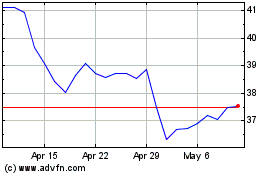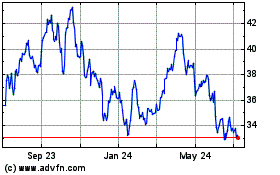Halliburton-Baker Hughes Deal: What Has Been Gained and Lost -- Heard on the Street
May 02 2016 - 1:10PM
Dow Jones News
By Spencer Jakab
If there is one economic concept an oil man intuitively grasps,
it is sunk costs.
Just as Halliburton boss David Lesar would advise clients to
walk away from a likely dry hole rather than pour good money after
bad, he pushed only as hard as was prudent to complete a merger
with rival Baker Hughes, a deal that ultimately fell apart. The
result: This week he will be writing that company a $3.5 billion
check.
The stock market doesn't seem to mind. On a weak day for
oil-field-service stocks, shares of both Halliburton, the intended
acquirer, and Baker Hughes, the target, gained in early
trading.
The fact that Halliburton didn't sink reflects that investors
long ago assigned scant odds to a successful deal. That was due to
given regulatory objections on both sides of the Atlantic.
Halliburton has the cash and, while the fee stings, it isn't facing
distress. Its shares actually did far better than the recipient of
its huge check.
Meanwhile, Baker Hughes may be awaiting a sum equal to about 16%
of its market value, but the failed merger took a hefty toll on it.
That highlights another economic concept: opportunity costs matter
just as much as direct ones.
During its first-quarter results last week, the company said it
was carrying $110 million of costs during the period that it might
have otherwise shed. The anticipated deal was the reason it didn't
do so. It also incurred some $306 million in after-tax
merger-related expenses in 2015 and the first quarter of 2016.
Finally, Baker Hughes has allowed potential investment
opportunities in a distressed industry to pass it by. The $2.5
billion or so in after-tax value it will realize from the break fee
it will get from Halliburton shouldn't really be viewed as an
outright windfall.
Granted, it does help. Rather than a complicated cost-benefit
analysis, the stock market's verdict on the failed merger's impact
on Baker Hughes shareholders is telling. The stock is just 6% lower
than just before the deal's announcement in November 2014. An
exchange-traded fund tracking the sector has shed 31% of its value
since then.
Baker Hughes wasted no time in telling investors how it would
deploy the cash after paying Uncle Sam: $1.5 billion in share
buybacks and $1 billion in debt reduction. It might have been able
to buy a smaller competitor such as an offshore driller with little
overlap and few regulatory complications. Instead, it is putting
its cash into something it knows best: itself.
Investors seeking one of the few companies in the industry with
fat left to trim and a healthy balance sheet could do worse than to
follow management's lead.
(END) Dow Jones Newswires
May 02, 2016 12:55 ET (16:55 GMT)
Copyright (c) 2016 Dow Jones & Company, Inc.
Halliburton (NYSE:HAL)
Historical Stock Chart
From Mar 2024 to Apr 2024

Halliburton (NYSE:HAL)
Historical Stock Chart
From Apr 2023 to Apr 2024
